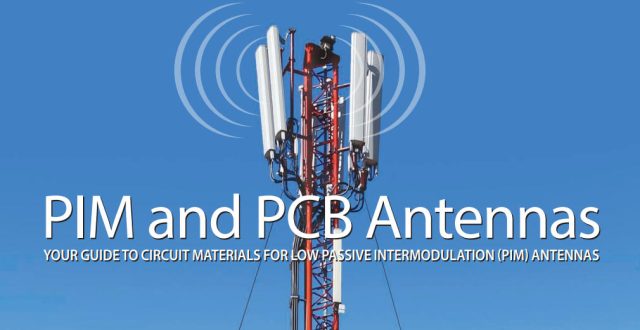Passive Intermodulation (PIM) has been a critical concern in wireless communication systems since the 1970s. PIM particularly affects systems that use a single antenna to both transmit and receive multiple carrier frequencies. Even minor nonlinearities can generate additional in-band signals at very low power levels, raising the noise floor and degrading system performance. With each new generation of wireless technologies, the impact of PIM becomes more pronounced.
Modern cellular networks, such as 4G LTE, rely on advanced modulation techniques to support high-speed data, video, and voice communication. These systems demand minimal interference and low PIM levels. Consequently, achieving low-PIM performance starts with selecting PCB laminates capable of minimizing PIM, alongside careful design, processing, and advanced testing.
1. Mechanism of PIM Generation
In an ideal linear system, multiple carrier frequencies coexist without generating new frequencies, though linear distortion of power levels may occur. When nonlinearity exists—such as an amplifier approaching saturation—linear combinations of the carrier frequencies can generate intermodulation (IM) products.
For two closely spaced carriers, f1f_1 and f2f_2:
-
Second-order IM products: 2f1, 2f2, f2-f1; generally outside the operating band
-
Third-order IM products: 3f1, 3f2, 2f1+f2, 2f1-f2, 2f2+f1, 2f2-f1; 2f1-f2 and 2f2-f1 may fall in-band, affecting system performance
-
Higher-order odd IM products (5th, 7th, 9th…): may also fall in-band, but at lower power than third-order products
PIM power levels are extremely low relative to transmitted signals. For example, a PIM level of -153 dBc corresponds to 5×10−165 \times 10^{-16} of the transmitted signal. However, because received signals are weak, even such low PIM levels can raise the noise floor and cause operational issues.
2. Key Factors Affecting PIM
Several factors on the transmitting side of a base station can significantly impact PIM:
-
Material factors
-
Ferrous or magnetic materials near the antenna can significantly increase PIM.
-
-
Connection quality
-
Conductive particles, chipped plating, or poor mating surfaces can introduce PIM.
-
-
System design
-
PIM is a system property, not a basic laminate property. Factors like current density and transmission line design are critical.
-
Key principle: minimizing current density in the design is crucial for achieving a low-PIM system. Optimizing conductor purity, dielectric formulation, and conductor–dielectric interface can significantly reduce PIM generation.
3. PCB Material Selection for Low-PIM Antennas
Rogers Corporation has conducted extensive research to determine PCB laminate properties that contribute to low PIM:
3.1 RO4500™ Thermoset Antenna Laminates
-
Composition: Ceramic-filled, glass-reinforced thermoset resin
-
Properties:
-
Dielectric constant (Dk, z-axis): 3.3–3.5 @ 10 GHz
-
Dissipation factor (Df): 0.0025–0.0037 @ 10 GHz
-
High thermal conductivity, suitable for high-power applications
-
-
PIM performance: < -157 dBc (12” microstrip test line, 0.060” thickness)
-
Examples: RO4533™, RO4534™, RO4535™
3.2 AD Series PTFE/Ceramic Antenna Laminates
-
Composition: Low-loss PTFE resin, selected fillers, fiberglass reinforcement
-
Properties:
-
Dk (z-axis): 2.50–2.97 @ 10 GHz
-
Df: 0.0014–0.0020
-
Low CTE for stable PTH formation
-
-
PIM performance: < -157 dBc
-
Examples: AD250C™, AD255C™, AD300C™
3.3 RO4725JXR™ and RO4730G3™ High-Performance Laminates
-
Dk: 2.55–3.0
-
Df: 0.0026–0.0027
-
PIM performance: < -160 dBc
-
These materials provide nearly undetectable PIM levels, ideal for antenna and other passive component designs.
4. PIM Testing Methodology
Rogers Corporation has routinely tested PIM since 2002, and now includes PIM monitoring in standard production:
-
Test circuit: 305 mm (12”) 50 Ω microstrip line, 1.5 mm (0.060”) laminate thickness
-
Frequency: 1900 MHz
-
Power: Two 43 dBm (20 W) tones
-
Measurement: Port 1 connected to PIM analyzer, Port 2 to low-PIM load; average PIM from four lines recorded
-
Notes: Repeated testing is crucial due to proximity to the noise floor
Design-dependent factors like current density can further improve PIM. For instance, RO4534™ transmission lines may achieve PIM better than -160 dBc through optimized layout.
5. Design and System Optimization Recommendations
-
Reduce current density: Optimize line width and layout to prevent high-current concentration.
-
Select high-purity conductors and low-loss laminates: Reduce nonlinearity and dielectric loss.
-
Control manufacturing process: Maintain uniform thickness, precise Dk, and high-quality PTHs and connections.
-
Perform repeated PIM testing: Validate prototypes and production batches to ensure low-PIM performance.
6. Conclusion
PIM is a critical factor affecting wireless system performance. For PCB antenna design:
-
PIM depends not only on material selection but also on design, current density, and manufacturing process.
-
Using Rogers RO4500™, AD Series, and high-performance RO4725JXR™/RO4730G3™ laminates provides a solid foundation for low-PIM designs.
-
Proper design and manufacturing practices, combined with repeated high-precision PIM testing, can achieve PIM levels below -160 dBc, ensuring optimal system performance.
Reference Laminate Selection Table:
| Laminate | Dk @10GHz | Df @10GHz | Thermal Conductivity (W/m/K) | PIM (dBc) |
|---|---|---|---|---|
| RO4533™ | 3.30 | 0.0025 | >0.60 | <-157 |
| RO4534™ | 3.40 | 0.0027 | >0.60 | <-157 |
| RO4535™ | 3.50 | 0.0037 | >0.60 | <-157 |
| RO4725JXR™ | 2.55 | 0.0026 | >0.40 | <-160 |
| RO4730G3™ | 3.00 | 0.0029 | >0.40 | <-160 |
| AD250C™ | 2.50 | 0.0014 | >0.30 | <-157 |
| AD255C™ | 2.55 | 0.0014 | >0.30 | <-157 |
| AD300C™ | 2.97 | 0.0020 | >0.50 | <-157 |
By combining optimized laminate selection with careful design and process control, PCB antennas can achieve exceptionally low PIM performance, meeting the stringent requirements of modern high-speed wireless systems.


